4th warmest June on record, wet and dull for most
Despite a cool start, June 2025 has become the 4th warmest on record for Ireland, with all stations recording mean temperatures above their Long Term Average (1991-2020 LTA) and Mount Dillon, Co Roscommon, recording the maximum temperature of the year so far, 29.6°C on Friday 20th June. Most stations saw rainfall above average (117% of the LTA for Ireland overall), making this June the 24th wettest since 1941.
The final third of the month has been remarkably hot for Europe, when an intense area of high pressure built over mainland Europe, provoking heatwave conditions to develop over it. While this happened over mainland Europe, Ireland stayed on the cloudier northern edge of the heat dome, which brought some uncomfortably high nighttime temperatures, contributing to the high June temperatures overall.
Key Figures:
- June 2025 was notably warmer than average, continuing the recent warmer-than-normal monthly trend. June 2025 was the 4th consecutive month with temperatures in the respective top 8 averages on record in 126 years of records.
- The average temperature for June 2025 (using the Island of Ireland dataset*) was 15.10 °C, making it the 4th warmest June on record since 1900.
- Of the top ten warmest Junes, five have occurred recently (2023, 2018, 2025, 2010 and 2006). The warmest June was in 2023 with an average temperature of 16.22 °C and the coldest June was in 1972 with an average temperature of 12.68 °C.
- The average temperature for June 2025 was 1.88 °C above the 1961-1991 long-term average for the month and 1.42 °C above the long-term average for the most recent climatological reference period of 1991-2020.
- Provisional gridded rainfall data suggests June 2025 averaged around 100 mm, which is 117% of the month’s long-term average from 1991-2020.
- 2025 ranks as the 24th wettest June in records since 1941 and the wettest June since 2022.
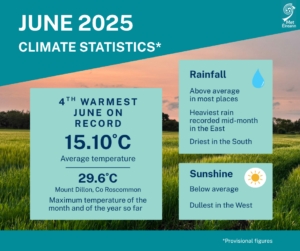
June 2025 Statistics
June 2025 was warm with above average rainfall overall. Winds were generally between westerly and southerly, which brought a lot of cloud. The first third of June was dominated by low pressure to the north of Ireland bringing a generally westerly airflow. It was cooler than average during this period. Several bands of frontal rain crossed from west to east, interspersed with sunshine and showers, with the bulk of the rain in the West and North.
The second third of the month was milder as low pressure stalled to the west and high pressure built to the east, bringing a southerly airflow. Initially, low pressure to the west was in control. Several frontal troughs pushed up from the south bringing bands of heavy rain, especially on Thursday 12th and Saturday 14th, with the heaviest falls in the East this time. Following this, high pressure built to the south and pushed north and then slowly moved east, drawing in a very warm air mass over the country from the south. This brought the hottest, driest and sunniest spell of the month between Monday 16th and Saturday 21st.
The final third of the month was relatively cloudy with low pressure to the northwest steering several frontal rain bands across the country from the west. At the same time an intense area of high pressure built over mainland Europe. Heat wave conditions developed over southern, western and central Europe. Ireland stayed on the cloudier northern edge of the heat dome, which brought some uncomfortably high nighttime temperatures.
Rainfall: Above average in most places, driest in the South
The majority of monthly rainfall totals were above their 1991-2020 Long-Term Average (LTA). Percentage of monthly rainfall values ranged from 56% (the month’s lowest monthly rainfall total of 47.0 mm) at Cork Airport, Co Cork to 206% (the month’s highest monthly rainfall total of 165.0 mm) at Athenry, Co Galway (its wettest June since 2012). The highest daily rainfall total was 42.6 mm at Casement Aerodrome, Co Dublin on Saturday 14th (its highest daily fall for June since 2009 and 64% of its June LTA).
The number of rain days* ranged from 19 days at both Dublin Airport, and Casement Aerodrome, Co Dublin to 26 days at both Athenry, Co Galway and Claremorris, Co Mayo. The number of wet days* ranged from 10 days at Casement Aerodrome, Co Dublin to 23 days at Athenry, Co Galway. The number of very wet days* ranged from 1 day at seven stations, including Oak Park, Co Carlow, to 5 days at Ballyhaise, Co Cavan, Finner, Co Donegal and Claremorris, Co Mayo. Generally stations in Leinster, Ulster and Connacht saw above average rainfall, while several stations in Munster saw below average rainfall.
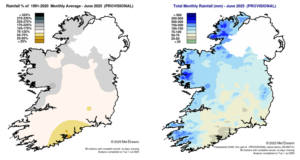
Rainfall % of 1991 – 2020 Monthly Average for June 2025 (Provisional) Total Monthly Rainfall (mm) for June 2025 (Provisional)
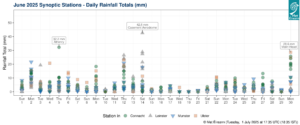
June 2025 Synoptic Stations – Daily rainfall totals (mm)
Temperature: Above average everywhere, warmest in the East
All mean air temperatures across the country were above their LTA for the month. Deviations from mean air temperature ranged from +0.6 °C at both Sherkin Island, Co Cork (14.5 °C mean temperature) and Roches Point, Co Cork (14.6 °C mean temperature) to +1.8 °C (15.5 °C mean temperature) at Casement Aerodrome, Co Dublin (its joint 3rd warmest June on record (length 61 years)). Mean temperatures for the month ranged from 13.7 °C (1.2 °C above its LTA) at Knock Airport, Co Mayo to 15.6 °C (1.7 °C above its LTA) at Phoenix Park, Co Dublin (its 4th warmest June on record (length 84 years)).
The month’s highest temperature was reported at Mount Dillon, Co Roscommon on Friday 20th, with a temperature of 29.6 °C (its 2nd highest June max on record (length 15 years)). The month’s lowest air temperature of 3.5 °C was reported at both Mount Dillon, Co Roscommon on Monday 2nd and Mullingar, Co Westmeath on Sunday 8th. The lowest grass minimum of -1.9 °C was reported at Mount Dillon, Co Roscommon on Monday 2nd. There were no air frosts reported this month. Less than half of stations reported ground frost. The number of days with ground frost ranged from zero days at most stations to 2 days at a few stations. Malin Head, Co Donegal had its highest maximum temperature for June since 1957 with 25.5 °C on Friday 20th. Two stations, Phoenix Park, Co Dublin (with 19.0 °C) and Oak Park, Co Carlow (with 18.1 °C) reported record high all-calendar-month minimum temperatures on Saturday 28th (using 09-09 UTC values). On the same day, Dublin Airport (with 18.4 °C), Casement Aerodrome, Co Dublin (with 18.0 °C), Dunsany, Co Meath (with 17.2 °C) and Johnstown Castle, Co Wexford (with 16.0 °C) reported record high minimum temperatures for June (using 09-09 UTC values).
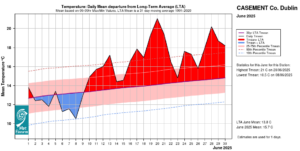
Casement Aerodrome, Co Dublin Temperature: Daily mean departure from LTA for June 2025 based on 09-09hr Max/Min values.
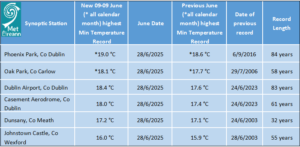
New (09-09 UTC) provisional June and all-calendar month high minimum temperature records reported at synoptic stations in June 2025.
Sunshine: Below average, dullest in the West
The majority of monthly sunshine totals were below their LTA. Percentage of monthly sunshine values ranged from 92% (monthly sunshine total of 152.6 hours) at Shannon Airport, Co Clare to 106 % (the month’s highest monthly sunshine total of 178.6 hours) at Casement Aerodrome, Co Dublin. Monthly sunshine totals were lowest at Knock Airport, Co Mayo with 92.6 hours (no LTA comparison*). The highest number of daily sunshine hours recorded this month was 15.0 hours at Johnstown Castle, Co Wexford on Wednesday 18th. The number of dull days* ranged from 3 days at a few stations to 7 days at several stations.
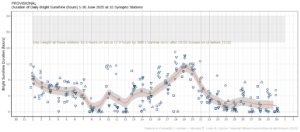
Hours of Bright Sunshine observed at nine stations for each day of the month of June 2025, grouped by province relative to the highest number of hours possible by end of month (shaded box).
Wind: Gales reported on one day at two stations
Monthly mean wind speeds ranged from 5.6 knots (10.4 km/h) at Ballyhaise, Co Cavan to 14.5 knots (26.9 km/h) at Mace Head, Co Galway. Gales were reported on Monday 2nd June at both Mace Head, Co Galway and Belmullet, Co Mayo. There were no strong gales or storms reported this month. The month’s 10-minute mean wind speed was reported at both Mace Head, Co Galway and Belmullet, Co Mayo on Monday 2nd, with 38 knots (70 km/h). The highest gust was 50 knots (93 km/h) reported at Belmullet, Co Mayo on Monday 2nd.
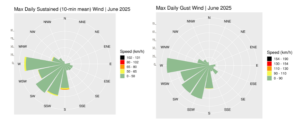
Wind roses for June 2025, sustained 10-min mean and gust.
Full PDF report and charts are available here
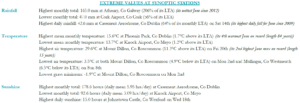
Extreme values for June 2025 at synoptic stations.
Notes to Editor:
- *Issued by Met Éireann on Wednesday 2nd July 2025. This report is based on available preliminary data from 25 principal weather stations operated by Met Éireann. Synoptic station data is midnight to midnight UTC. Long-Term Averages (LTAs) and “average” refer to the period 1991-2020 unless stated.
- A rain day is a day on which 0.2 mm or more of rainfall is measured. A wet day is a day with 1.0 mm or more of rainfall. A dull day is a day with less than 0.5 hours of sunshine. A very wet day is a day with 10.0 mm or more of rainfall.
- Climatological dry periods – An absolute drought is a period of 15 or more consecutive days to none of which is credited 0.2 mm or more of precipitation. A partial drought is a period of at least 29 consecutive days, the mean daily rainfall of which does not exceed 0.2 mm. A dry spell is a period of 15 or more consecutive days to none of which is credited 1.0 mm or more of precipitation (i.e. daily tot < 1.0 mm).
- A heatwave occurs where there are 5 consecutive days or more with maximum temperature over 25°C (that is, a daily maximum screen air temperature > 25° C).
- The ‘Island of Ireland’ dataset is 125 years long and runs between 1900 and 2023. For this dataset the long term averages from the 1961-1990 reference period are used for comparison as is standard for long-term climate change assessments.
- Sunshine data is from the Autosol Network. LTAs for these sites are currently not used for comparison purposes.
- For more information or interview opportunities with a Met Éireann spokesperson, please contact us at enq@met.ie.